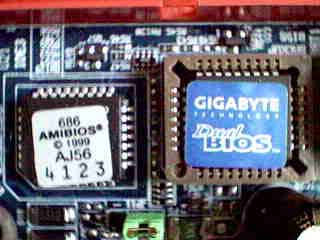Gigabyte GA-6RX Apollo Pro266 ATX
by Mike Andrawes on March 8, 2001 2:15 AM EST- Posted in
- Motherboards
Packing in the Sweets
Another important feature of the GA-6RX is the Promise on-board IDE RAID controller, which is also what Gigabyte used on their KT133 motherboard, the GA-7ZXR. The controller chip that the GA-6RX uses is the PDC20265R and it is capable of Ultra ATA 100 as well as RAID operation. There is a jumper on the motherboard for you to select whether you want to use the controller as a second Ultra ATA 100 IDE controller or as a RAID controller.

Promise PDC20265R IDE RAID controller
If you choose to use it as a second Ultra ATA 100 controller, you will be able to connect up to four IDE devices to the two channels (two devices per channel). Combining that with the two IDE channels supported by the 8233 South Bridge you are be able to support a total of eight IDE devices on the GA-6RX.
If you select to use the controller for RAID purposes, you will be able to get into the controller's BIOS and set the controller for RAID 0 or RAID 1 configuration. RAID 0 configuration makes use of two drives and performs striping of data between the two drives, thus boosting the overall disk read/write performance. RAID 1 configuration also uses two drives, but it does not yield any write performance gain and a potential read performance gain as RAID 1 simply mirrors the data across a minimum of two drives. Interestingly enough, a RAID 0+1 configuration (striping + mirroring) is not supported by the Promise controller on the GA-6RX.
Implemented in most Gigabyte products, the Dual BIOS feature helps to increase the reliability of the motherboard against faulty BIOS upgrades or virus attacks. Basically if one of the two BIOS chips are corrupted, either by virus attack or an unsuccessful BIOS flash, and the system refuses to boot, the second BIOS chip will step in and allow you to safely boot the system. This can dramatically reduce RMA rates for Gigabyte since quite a few returns tend to be caused by incorrectly flashed BIOSes.

Gigabyte's Dual BIOS setup
The memory configuration options on the GA-6RX are pretty standard for a DDR board. For CAS latency, you are allowed to choose between CAS 2 and CAS 2.5, and you can also choose to run the memory with 2-bank or 4-bank interleaving enabled. One thing to note is that during our testing we were not able to run our DDR SDRAM at CAS2 with 4-bank interleave enabled. With either one of them enabled the system ran flawlessly, but with both options enabled the system couldn’t finish any of the tests. This could be an issue with the feature's implementation on the board since DDR is still relatively new technology to motherboard manufacturers.
To make life easier for beginners, Gigabyte also includes two software packages for better user support. The first one is called the @BIOS, which allows people to upgrade their BIOS from within Windows. While most users still prefer to flash their BIOS from DOS, Microsoft's phasing out of DOS with Windows 2000 and Windows Millennium, allowing for BIOS updates in the Windows environment is becoming increasingly important.
The second software package included is Gigabyte's own EasyTune III, which is essentially a software-overclocking tool where you are allowed to increase the FSB speeds of your system from within the Windows environment as well. There are two modes of operation. During the easy mode, the software will optimize the overclocking job itself, and during the advanced mode, you will have the chance to increase the FSB speeds manually. Again most people still prefer to do overclocking in the BIOS, but for most beginners, who are not entirely comfortable with BIOS overclocking, the EasyTune III does provide a friendlier environment.
The 127-page manual provided with the GA-6RX contains a lot of information for the user. It talks about the overall architecture of the board, all the jumpers, dipswitches, and connectors, both their functions and settings. You can also find details on the BIOS and RAID setup, as well as the software setup for the sound device. Some brief instructions were found on how to install the motherboard, CPU, and memory, but it would be better if Gigabyte also included brief instructions on chipset driver installation.










0 Comments
View All Comments